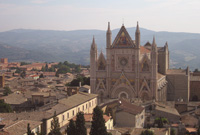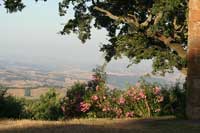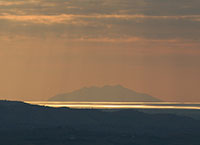| |
|
| |
|
|
|
|
|
|
| |
 |
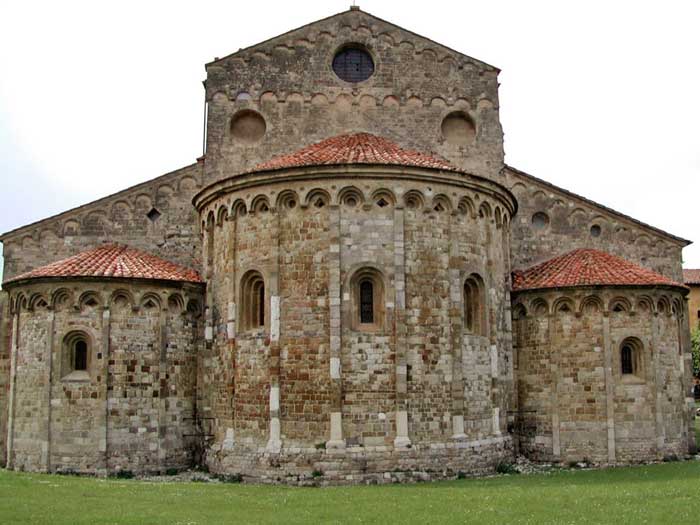 |
| |
Basilica di San Piero a Grado, Pisa |
|
 |
 |
| |
|
|
|
| |
|
Pisa | San Pietro a Grado
|
|
|
|
| |
|
San Piero a Grado or Basilica di San Piero Apostolo is a church in Pisa, in the eponymous frazione. The church is located where once was a now disappeared port of the Pisan Republic, where, according to the legend, St. Peter landed in Italy from Antiochia in 44 AD.
History and overview
Archaeological excavations have shown the presence of a Palaeo-Christian edifice in the area, built over civil Roman structures, which was later replaced by a larger church in the early Middle Ages (8th-9th centuries). The current construction, begun in the 10th century and renovated in the late 11th-early 12th centuries, has a basilica plan with a nave and two aisles. Unusual is the presence of an apses the facade, probably built after the crumbling of the facade due to a flood of the Arno river. The entrance is on the northern side.
The exterior, made of stone of different provenance, is marked by pilaster strips and arches over which are precious ceramic basins (the originals are in the National Museum of St. Matthew in Pisa) of Islamic, Majorca and Sicilian manufacture decorated with geometrical and figurative motifs (10th-11th centuries).
The 12th century bell tower was destroyed in 1944. Only the base has been rebuilt.
The large and solemn interior, with truss ceiling, is divided into a nave and two aisles by antique columns with classical capitals. In the western part is a Gothic ciborium (early 15th century) which marks the place where Peter would pray for the first time.
On the walls of the nave is a large fresco cycle, recently restored, by the Lucchese Deodato Orlandi (early 14th century), which was commissioned by the Caetani family for the 1300 jubilee. In the lower part are Portraits of Popes, from St. Peter to John XVIII (1303); the intermediate portion has thirty panels with Histories of St. Peter's Life (as well of those of St. Paul, Constantine and St. Sylvester), similar to those in the Old St. Peter's Basilica and to Cimabue's work at San Francesco in Assisi. In the upper area are portrayed the Walls of the Heaven City, largely restored in the following centuries.
On the high altar is a wooden crucifix from the 17th century.
|
Originally the facade of the Basilica faced the West (photo on the right) and the three apses the East. It was changed at the end of the XII century, following the collapse of the facade perhaps damaged by floods, to the present building, thus resulting shorter in lengh and with the apses on opposite sides to one another, because of the addition of another apses in place of the facade. In the same century and the same area, the bell tower was raised, a very solid tower 37 meter high, from whose summit could be seen the entire plane between Pisa and Livorno, the Islands of the Tuscan Archipelago right to the boundary with Liguria. This bell tower was mined by the Germans troops in retreat in 1944, and partly rebuilt with the original material in the '50s.
Today the present Basilica appears as an impressive building with three naves, with three apses to the east and one to the west, the main entrance being to the north, since it does not have a proper facade.
|
|
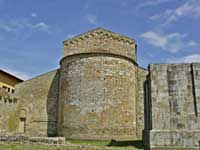 |
|
|
|
| |
|
San Pietro a Grado | The frescoes
|
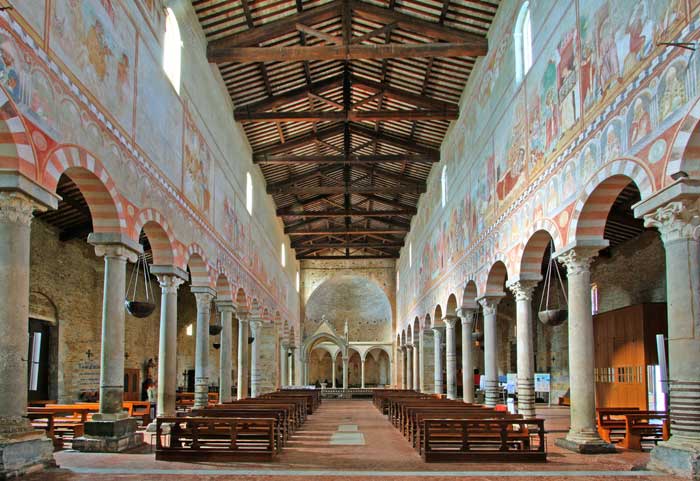 |
Basilica di San Piero a Grado, Pisa, interior with frescoes by Deodato Orlandi
View from the high altar. In the background the Ciborium
|
The murals date from the latter 1200/s and early 1300/s, and were executed by Deodato Orlandi, an artist from Lucca, who at that time worked at Pisa. He seems to repeat in the area around the central nave designs illustrating the life of St. Peter, from the call of jesus (elevated, at the right main altar) to the episodes from the Act of the Apostles, to the coming at the "ad gradus arnenses", to martyrdom and burial together with tath of St. Paul. The murals are similar to the ones that existe in the atrium of the old basilica St. Peter at the Vatican which as been demolished. Underneath the immense paintings above the arches are portraits of the various Pontiffs from St. Peter to John XVIII, who was Pope from 1004 to 1009. Thissingular succession of images of the papal succession is reminescent of those which exist in St. Paul's at Rome; the difference is that those in St.Piero a Grado are much older. The mural of the aisles were lost due to the negligence of time and the notable tranformations the church has undergone during thr course of thr centuries. There remain, however, a few traces, visible especially, in the left aisles and in the apse ceiling; they testimony to the cultural value which the church must have had.
[source: www.comune.pisa.it] |
|
|
|
|
|
| |
|
|
|
 |
|
 |
Orvieto, Duomo |
|
Siena, Duomo |
|
Florence, Duomo Santa Maria del Fiore |
| |
|
|
|
|

Pictures from the exterior, interior and frescoes | Basilica of St. Piero a Grado, Pisa – Italy

[1] Deodato di Orlandi was an eclectic and apparently prolific artist whose works record the transition from Italo-Byzantine painting of the 13th century to the Giottesque milieu of the 14th. They also indicate the importance of Florentine styles for Lucchese painting in his time. The earliest work attributed to him is a Crucifix with a living Christ (c. 1280; Pisa, Museo Nazionale di San Matteo), and if this attribution is correct it suggests that his early development was influenced by Berlinghiero Berlinghieri.
Deodato was probably the 'Datuccius Orlandi' documented in 1284, and in 1288 he signed a richly ornamented Crucifix for San Cerbone, Lucca (Lucca, Villa Guinigi). This was evidently strongly influenced by Cimabue, for example in the way the hair spills from the (rather larger) head on to Christ's shoulder, although the figure of the dead Christ has none of Cimabue's monumentality. The style is linear, largely devoid of chiaroscuro though not without grace, and the modelling is barely structural. Some attempt has been made to reproduce the translucent drapery of the Christ of Cimabue's later Crucifix (Florence, Santa Croce), but the swaying body keeps closer to the axis of the apron than is the case with Cimabue's versions. The terminal figures of St John and the Virgin are seen in three-quarter length.
|
| |

Podere Santa Pia is a beautiful farmhouse that dominates one of the most beautiful setting that nature can offer: the countryside in the Tuscan Maremma.
Tuscany Holiday Homes | Podere Santa Pia
|
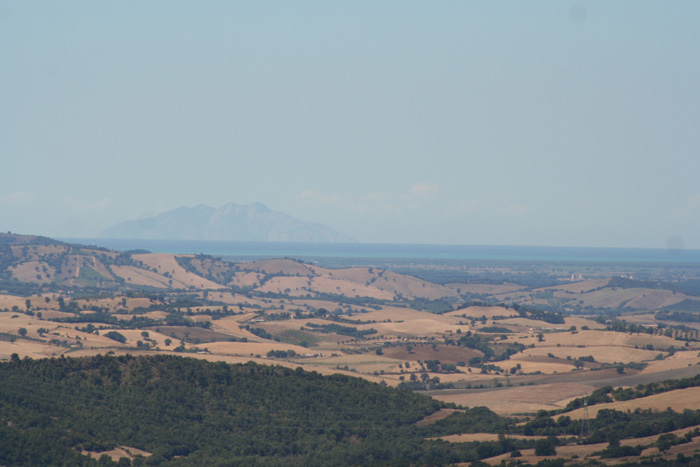 |
|
| |
|
|
|
|
|
|
|
|
|
|
Podere Santa Pia |
|
Podere Santa Pia, garden (June) |
|
Montecristo, view from Santa Pia
|
| |
|
|
|
|
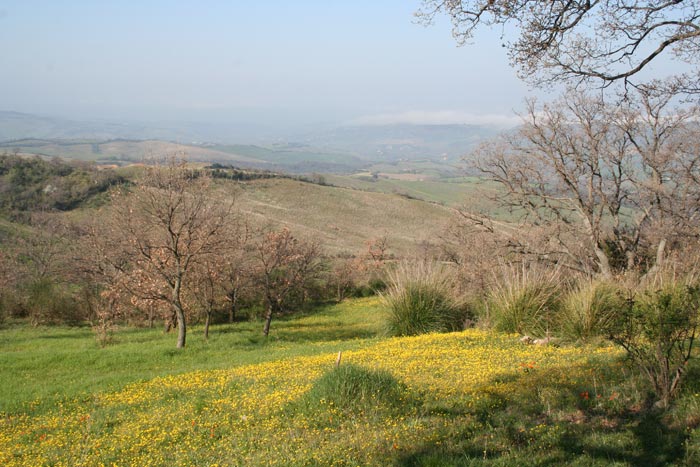 |
Podere Santa Pia, view on the garden from th southern terace (April) |

Pisa | Sant'Antonio: Historical Quarter in Mezzogiorno | http://www.behindthetower.com/en/pisa/sights/santantoniopisa
Mazzini’s House is a museum, situated in the former house of the Nathan-Rosselli family, situated in Via Mazzini, 71.
Here, Giuseppe Mazzini lived until his death, and the building is now also the seat of a Centre for Mazzinian Studies, a very important library rich in original documents relating to the Italian Risorgimento, the period that lead to the unification of the nation.
Explore the little medieval streets behind Corso Italia: they are a perfect example of medieval architecture.
Back on the Lungarno, after Palazzo Gambacorti, heading south, there is a very ancient church, Santa Cristina and opposite the church, there are the ruins of an old building. That was the house where Saint Catherine of Siena lived in Pisa and in the Church of Santa Cristina she received the stigmata.
The Lungarno Gambacorti has a number of interesting buildings. Many of them are a perfect example of the typical Pisan Tower Houses, which were cut off by the Florentines after they conquered the city.
You will soon see the little white marble Church of Santa Maria della Spina along side of the river. The name comes from the relic that was once kept in the church, one of the thorns from Christ's Crown, now preserved in the Church of Santa Chiara, inside the University Hospital. The statue of the Holy Virgin with the baby on the highest spire is by Nicola Pisano, although this is only a copy. The original has been moved to the national Museum of San Matteo.
A few steps past the gothic church is Ponte Solferino (Solferino Bridge), which marks the beginning of Lungarno Sonnino. This stretch of Lungarno between the bridge and the Porta a Mare City Gate (literally Gate leading to the sea), hosts two of the most interesting buildings in Pisa: the former Benedictine Monastery with the little church of Saint Benedict (1393), which now belongs to the bank Cassa di Risparmio di Pisa, and the beautiful church of San Paolo a Ripa d'Arno standing in a tree lined square and a very nice garden.
San Paolo a Ripa d'Arno is one of the most beautiful places in Pisa. Legend says that on the riverbank here, Pier delle Vigne, a very famous poet, committed suicide after the false accusation of betrayal by his lord Frederick II. San Paolo a Ripa d'Arno was founded in 803 and it is also known as Duomo Vecchio (Old Cathedral). The inside of the church is very simple and suggestive. Admire the Roman Sarcophagus located above the left-hand side door which hosts the body of the famous philologist Burgundio (13th century).
The
Chapel of Saint Agata is a little octagonal chapel, just behind San Paolo a Ripa d'Arno. The chapel dates back to the 11th century, when the Pisans had it built to celebrate their victory over the Palermitans
From the Porta a Mare, a perfectly preserved gate, the Florentines entered Pisa at the beginning of the 14th century and conquered the city.
The historical Quarter of Sant'Antonio ends at the bridge called Ponte della Cittadella. If you cross the bridge you enter the historical quarter of Santa Maria.
[source: | www.behindthetower.com]
|
This page uses material from the Wikipedia article San Pietro a Grado, Buonamico Buffalmacco and Pisa, published under the GNU Free Documentation License, and from a leaflet "A brief story of the origins of the Basilica, its architecture, murals and traditions", Propositura di San Pietro Apostolo - San Piero a Grado - Pisa.
Wikimedia Commons has media related to Pisa and San Piero a Grado basilica. |
|
|
| |
|
|
|
| |
|
|
|
| |
|
|
|
| |
|
|
|
| |
|
|
|
| |
|
|
|
![]()
![]()
![]()
![]()




